

![]()
HERDING DOGS OF WESTERN EUROPE
THE HERDING DOGS OF BELGIUM
The Belgian Shepherd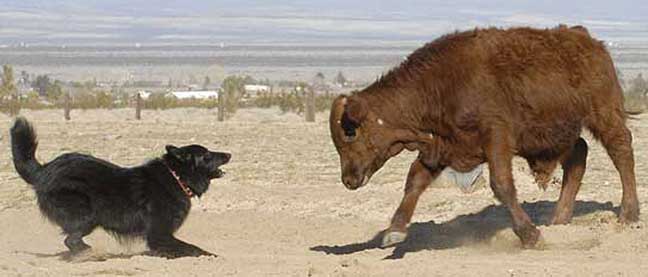
Above, a Groenendael, "Uvar" ("Uvar Eresha Kuymal") belonging to Peggy Richter of Kuymal Belgians, faces down a calf.
You can see that he is not just facing it, but barking. (Photo by Cathy Modica, with permission from the dog's owner.)
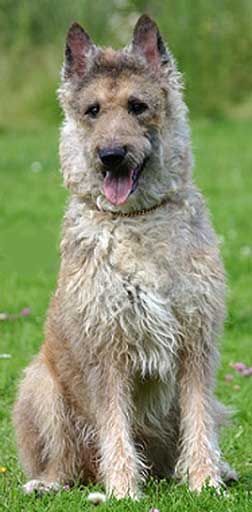 A Laekenoise, "Humlans Ferocious Fang". (Photo from Wikipedia by Christoffer Magnerholt. The copyright holder of this work published it under the terms of the GNU Free Documentation License.)
A Laekenoise, "Humlans Ferocious Fang". (Photo from Wikipedia by Christoffer Magnerholt. The copyright holder of this work published it under the terms of the GNU Free Documentation License.)
There are four types of Belgian Shepherds: the Groenendael, the Laekenois, the Malinois, and the Tervuren. They are quite simply four different varieties of the same breed of herding dog, but in some countries, most notably the USA, they are considered separate breeds. Like in most European countries, prior to the end of the 19th century, there were a great many shepherd dogs with a great variety of looks. According to Worldly Dogs, a website that focuses on the history of dog breeds, "Selective breeding for each type began in the late 19th century, when individual breeds were being listed into a group of dogs known as the Continental Shepherds. This group included German, French, and Dutch shepherd dogs...Eventually (1891) a club known as the Club du Chien de Berger Belge (Belgian Shepherd Club) was formed and they began the process of finding and breeding dogs that were found only in Belgium."
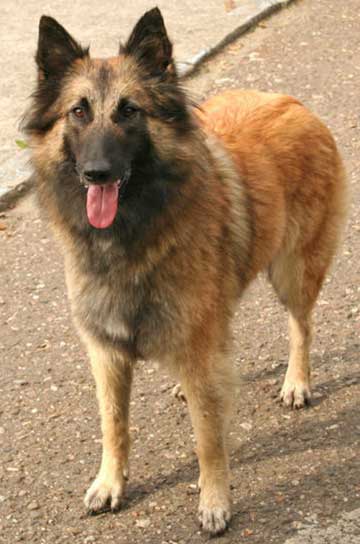 Prior to this, they were all local shepherd or farm dogs. Even after the club formed, breeders considered it important for inter-variety breeding to take place to maintain the health of the breeding lines. The only genes these types do not have in common are for coat type. However, once they began to be shown in conformation, and once the Belgian Shepherd was recognized by the FCI, breeding between the types was no longer allowed. During World War II Belgium was occupied and breeders were not allowed to keep several dogs. After the war, the types had to be re-established from the few remaining dogs. Nothing is written about it, but it is conceivable that in order to restore the Belgian types, those remaining were bred with other European herding breeds. As we have seen with other breeds, it wouldn't be unusual.
Prior to this, they were all local shepherd or farm dogs. Even after the club formed, breeders considered it important for inter-variety breeding to take place to maintain the health of the breeding lines. The only genes these types do not have in common are for coat type. However, once they began to be shown in conformation, and once the Belgian Shepherd was recognized by the FCI, breeding between the types was no longer allowed. During World War II Belgium was occupied and breeders were not allowed to keep several dogs. After the war, the types had to be re-established from the few remaining dogs. Nothing is written about it, but it is conceivable that in order to restore the Belgian types, those remaining were bred with other European herding breeds. As we have seen with other breeds, it wouldn't be unusual.
Right, a Belgian Terveren female, considered too light and with poor masking, which shows what beautiful animals are wasted by the Dog Fancy because they don't measure up to "standards". (Photo from Wikipedia by Pleple2000. The copyright holder of this work published it under the terms of the GNU Free Documentation License.)
Below, a Belgian Malinois. Photo in Public Domain, no credit or attribution was supplied.
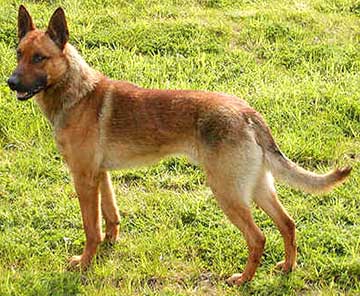 All the Belgian Sheepdogs today are considered medium-sized dogs, but for our purposes they are large dogs. In Europe, when the flocks were being moved, it was common for the shepherd to walk before the flock and the dog to bring up the rear and be ready to dash from one side to the other to discourage strays. Since Belgium, like the Netherlands, is a low, flat country, there were no long distant treks and flocks were only moved locally. Dogs were also expected to keep the flock out of planted fields. When moving smaller flocks, the shepherd went behind, accompanied by his dog in a similar fashion to Britain, though sometimes the dogs went before the flock. While Belgian Shepherds do not possess "eye" and are loose-eyed upright workers, they are still capable of controlling recalcitrant stock. Although there are breeders who work hard to retain the herding instinct in their lines today, only a very few Belgian Shepherds work stock today on a regular basis.
All the Belgian Sheepdogs today are considered medium-sized dogs, but for our purposes they are large dogs. In Europe, when the flocks were being moved, it was common for the shepherd to walk before the flock and the dog to bring up the rear and be ready to dash from one side to the other to discourage strays. Since Belgium, like the Netherlands, is a low, flat country, there were no long distant treks and flocks were only moved locally. Dogs were also expected to keep the flock out of planted fields. When moving smaller flocks, the shepherd went behind, accompanied by his dog in a similar fashion to Britain, though sometimes the dogs went before the flock. While Belgian Shepherds do not possess "eye" and are loose-eyed upright workers, they are still capable of controlling recalcitrant stock. Although there are breeders who work hard to retain the herding instinct in their lines today, only a very few Belgian Shepherds work stock today on a regular basis.
Below right, a Tervueren with the "correct" masking. (Photo from Wikipedia by Ulrik Fallström and licensed under the Creative Commons Attribution-Share Alike 2.5 Generic.)
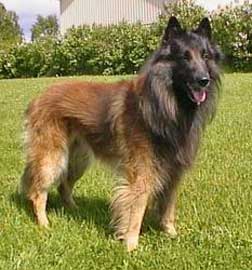 The Groenendael is a rough coated all-black dog. This is the dog that is known in the USA as "The Belgian Sheepdog". Its size is between 22 and 26 inches.
The Groenendael is a rough coated all-black dog. This is the dog that is known in the USA as "The Belgian Sheepdog". Its size is between 22 and 26 inches.
The Laekenois has a wire-haired coat and an appearance similar to the Picardy. The color is tan and white, sometimes with black shading on the muzzle and tail, which implies a gene for either sable or melanistic mask (see our Glossary). This type developed as a herding dog at the Royal Castle of Laeken, the seat of the Belgian Royal Family, north of Brussels. It is considered the oldest and most rare of the four Belgian types.
The Malinois is a smooth-coated dog similar in looks to the GSD. The coat is tan (called mahogany) with a black mask. In size it is similar to the Groenendael. Also, like the GSD, it is used primarily as a working dog for police work, search and rescue, protection, and dog sports.
The Tervuren is a rough-coated dog similar in appearance to the Groenendael, but with a sable coat (called red) and black mask.
The Leauvenaar and the Schipperke
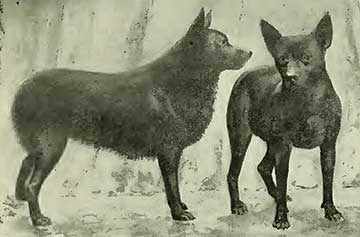 Left, two Schipperkes, circa 1897, "Midnight" and "Darkness", that belonged to W.J. Comstock, Providence, R.I. (Photo in the Public Domain.)
Left, two Schipperkes, circa 1897, "Midnight" and "Darkness", that belonged to W.J. Comstock, Providence, R.I. (Photo in the Public Domain.)
Leauven is the capital of Flemish Brabant, a region in the Flemish area of Belgium. At one time there was a sheepdog from this region, called the Leauvenaar, but since little or no information is available on it except to say it was an all-black medium-sized dog, it is likely that this dog is extinct. It was possibly of the spitz family. It is said that the Schipperke, and maybe even the Groenendael, originated in the Leauvenaar, and that the Schipperke was developed by breeding down the Leauvenaar when, sometime in the early 19th century, peasants were restricted in the size of dogs they could keep. However, others say that the Schipperke has been around since at least 1690 when a show for Schipperkes was held in the Grand Place de Brussels. The Schipperke has been known to have retained some herding ability from its sheepdog ancestor, and its name may be a corruption of the Dutch word scheperke or "little shepherd"; but it was primarily used as a small watchdog on the Dutch barges, as a vermin control dog, and for nipping (or, you might say, herding) the heels of the horses that towed the barges to keep them moving.
Copyright © 2014 by Carole L. Presberg
Resources:
Canadian Kennel Club: Schipperke www.ckc.ca/en/Default.aspx?tabid=99&BreedCode=SHP
Niavana Belgian Shepherds www.niavanabelgians.co.uk/new_page_3.htm
Wikipedia: "Belgian Shepherd Dog (Groenendael)" en.wikipedia.org/wiki/Belgian_Shepherd_Groenendael
Wikipedia: "Belgian Shepherd Dog (Laekenois)" en.wikipedia.org/wiki/Belgian_Shepherd_Laekenois
Wikipedia: "Belgian Shepherd Dog (Tervuren)" en.wikipedia.org/wiki/Belgian_Shepherd_Tervueren
Wikipedia: "Belgian Shepherd Dog (Malinois)" en.wikipedia.org/wiki/Belgian_Shepherd_Malinois
Worldly Dogs: "Belgian Breeds - The Groenendael (www.worldlydogs.com/groenendael.php)
Return to
![]()
BORDER COLLIE COUSINS
THE OTHER WEB PAGES WE MAINTAIN
These web pages are copyright ©2014
and maintained by webmeistress Carole Presberg
with technical help from webwizard David Presberg
ALL RIGHTS RESERVED
If you are interested in using ANY material on this website, you MUST first ask for permission.